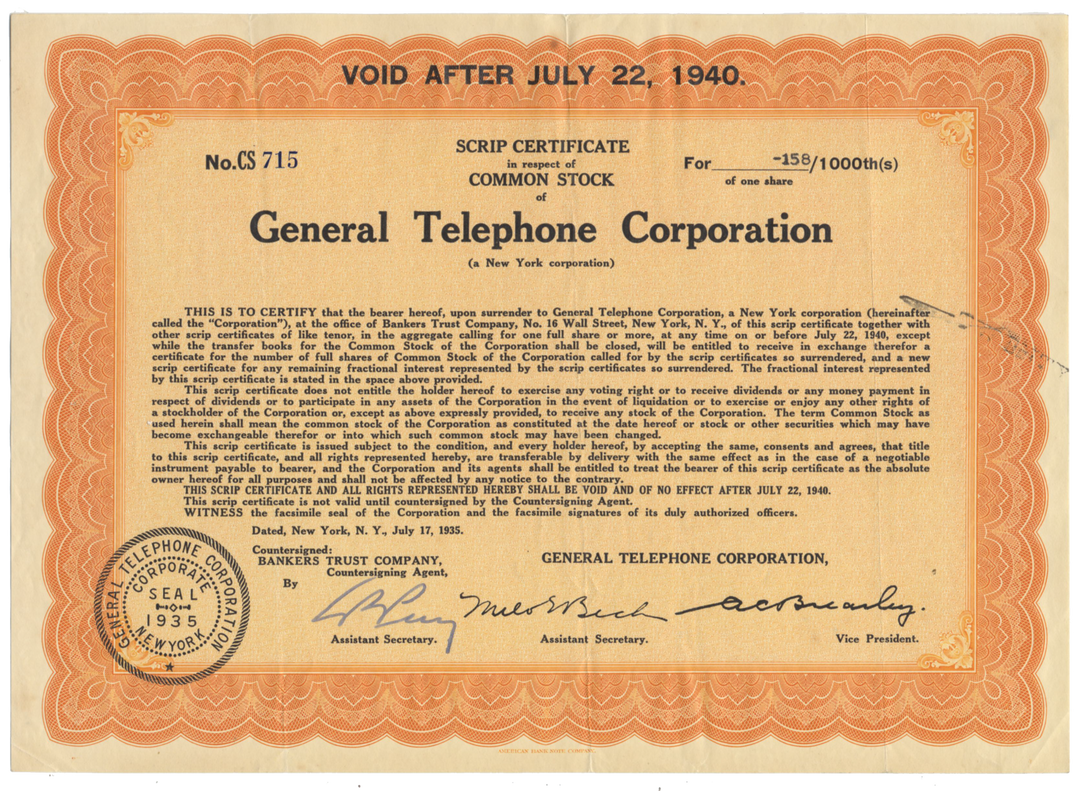
General Telephone Corporation (GTE)
- In stock
- Backordered, shipping soon
- Guaranteed authentic document
- Orders over $35 ship FREE to U. S. addresses
- Earn rewards points with every order
Product Details




Certificate Type
Common Stock Scrip
Date Issued
July 17, 1935
Canceled
No
Printer
American Bank Note Company
Signatures
Machine printed
Approximate Size
11" (w) by 7 3/4" (h)
Additional Details
NA
Historical Context
The early GTE structure was forged primarily through an aggressive history of acquisitions and mergers -- beginning with the acquisition of hundreds of small telephone companies independent of the Bell System. These companies had been formed following the 1894 expiration of the last of the telephone patents granted to Bell. This expansion movement reached its zenith in the late 1950s with the combination of three large corporations that formed the nucleus of the GTE as it was structured in 1990: General Telephone, Theodore Gary and Co., and Sylvania Electric Products Inc.
GTE was conceived as a corporate entity in 1918 when John F. O'Connell, Sigurd L. Odegard and John A. Pratt purchased the small Richland Telephone Co. in Wisconsin. The partnership became a corporation two years later, with the acquisition of other Wisconsin telephone properties. Later, the corporation purchased a Long Beach, California, telephone company, and a holding company called Associated Telephone Utilities Company was organized in 1926 to serve as an umbrella for the Wisconsin and California properties.
Associated Telephone Utilities served 500,000 telephones before the stock market crash of 1929 and the Great Depression that followed. Depleted financial resources forced the corporation into receivership in 1933, but it emerged two years later, reorganized as General Telephone Corp.
The Missouri roots of Theodore Gary and Co. stretched back even further than those of Associated Telephone Utilities. Gary purchased the Macon, Missouri, telephone exchange in 1897. Bitter competition developed when American Bell Telephone Company, AT&T's predecessor, tried to wipe out the independent telephone companies, sometimes leading to physical violence. The resolution of this conflict was the previously mentioned 1913 Kingsbury Commitment.
In the meantime, Gary was acquiring domestic and international telephone companies at a rapid rate. Theodore Gary and Co. and General Telephone were the two largest independent telephone companies in the United States when they merged in 1955.
Sylvania Electric Products began modestly in the 1910s in Massachusetts and Pennsylvania as a renewer of burnt-out light bulbs. Operations in both states moved on to production of new lamps and then to vacuum tubes in the 1920s, when radio broadcasting became increasingly popular. In 1931, the Massachusetts and Pennsylvania companies merged to become Hygrade Sylvania Corporation , later Sylvania Electric Products. By the time it merged with General Telephone in 1959, Sylvania had become a leader in electronics, lighting, television and radio, and chemistry and metallurgy.
After this 1959 merger, the company became known as General Telephone & Electronics Corp. Donald C. Power, the first major architect of what was to become GTE, engineered General Telephone's mergers with Theodore Gary and Company and Sylvania. As head of General Telephone, Power advocated a decentralized management, and operations of the three companies were not integrated. In addition to telephone company operations, the conglomerate-styled business participated in a diverse range of enterprises, producing a remarkable range of products over the following decades, including halogen automobile headlights, cutting tools, telecommunications equipment, cameras, television sets, atomic-reactor fuel elements, anti-missile defense systems, and space frame systems for buildings.
During this time, the holding company, based in New York, became known as GT&E Corp. In March 1970, blasts ripped through the headquarters buildings of GT&E and two other companies in New York; the terrorist group responsible was protesting the companies' participation in defense work at the height of the Vietnam War. In December 1970, GT&E announced that the company would move its world headquarters to Stamford, Connecticut. In 1971, the company adopted a new corporate symbol that became a widely recognized logo in the years to come, featuring the initials GTE placed inside a blue, rounded rectangle, and the company formally changed its name to GTE Corp. in 1982.
Related Collections
Additional Information
Certificates carry no value on any of today's financial indexes and no transfer of ownership is implied. All items offered are collectible in nature only. So, you can frame them, but you can't cash them in!
All of our pieces are original - we do not sell reproductions. If you ever find out that one of our pieces is not authentic, you may return it for a full refund of the purchase price and any associated shipping charges.


